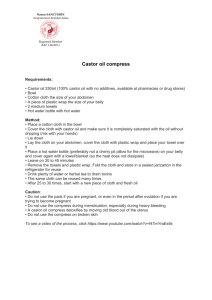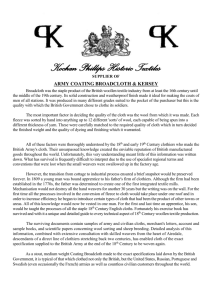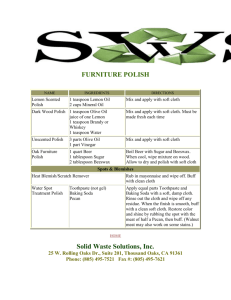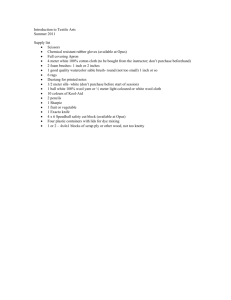Word Document
advertisement
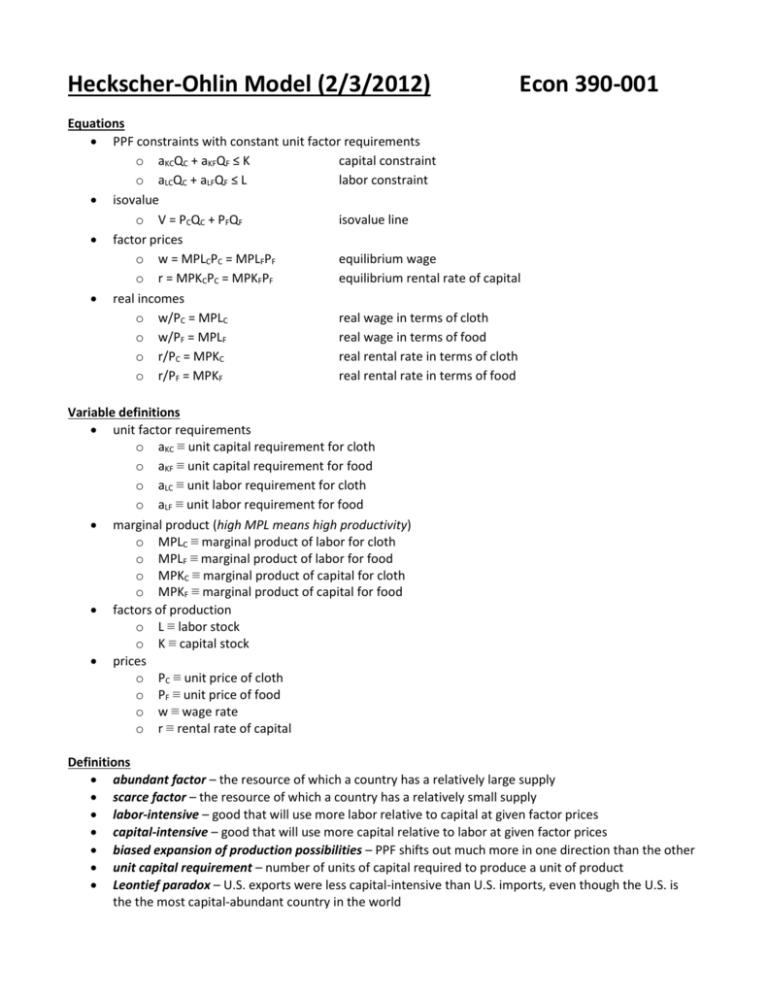
Heckscher-Ohlin Model (2/3/2012) Econ 390-001 Equations PPF constraints with constant unit factor requirements o aKCQC + aKFQF ≤ K capital constraint o aLCQC + aLFQF ≤ L labor constraint isovalue o V = PCQC + PFQF isovalue line factor prices o w = MPLCPC = MPLFPF equilibrium wage o r = MPKCPC = MPKFPF equilibrium rental rate of capital real incomes o w/PC = MPLC real wage in terms of cloth o w/PF = MPLF real wage in terms of food o r/PC = MPKC real rental rate in terms of cloth o r/PF = MPKF real rental rate in terms of food Variable definitions unit factor requirements o aKC ≡ unit capital requirement for cloth o aKF ≡ unit capital requirement for food o aLC ≡ unit labor requirement for cloth o aLF ≡ unit labor requirement for food marginal product (high MPL means high productivity) o MPLC ≡ marginal product of labor for cloth o MPLF ≡ marginal product of labor for food o MPKC ≡ marginal product of capital for cloth o MPKF ≡ marginal product of capital for food factors of production o L ≡ labor stock o K ≡ capital stock prices o PC ≡ unit price of cloth o PF ≡ unit price of food o w ≡ wage rate o r ≡ rental rate of capital Definitions abundant factor – the resource of which a country has a relatively large supply scarce factor – the resource of which a country has a relatively small supply labor-intensive – good that will use more labor relative to capital at given factor prices capital-intensive – good that will use more capital relative to labor at given factor prices biased expansion of production possibilities – PPF shifts out much more in one direction than the other unit capital requirement – number of units of capital required to produce a unit of product Leontief paradox – U.S. exports were less capital-intensive than U.S. imports, even though the U.S. is the the most capital-abundant country in the world Theorems Stolper-Samuelson theorem – If the relative price of a good increases, then the real wage or rental rate of the factor used intensively in the production of that good increases, while the real wage or rental rate of the other factor decreases. Rybczynski theorem – If you hold output prices constant as the amount of a factor of production increases, then the supply of the good that uses this factor intensively increases and the supply of the other good decreases. Heckscher-Ohlin theorem – An economy has a comparative advantage in producing, and thus will export, goods that are relatively intensive in using its relatively abundant factors of production and will import goods that are relatively intensive in using its relatively scarce factors of production. Principles Heckscher-Ohlin Model o Trade occurs due to differences in resources. o Countries have different relative abundance of factors of production. o Production processes use factors of production with different relative intensity. assumptions 1) 2 countries: home & foreign. 2) 2 goods: cloth & food. 3) 2 factors of production: labor & capital. 4) Mix of labor and capital used varies across goods. 5) Supply of labor and capital: o constant in each country o varies across countries 6) Both labor and capital are mobile factors (long run). o equalize returns (wage & rental rate) across sectors. empirical problems o Heckscher-Ohlin predicts that factor prices will be equalized among countries that trade. Free trade equalizes relative output prices. The model links output prices to factor prices. Thus factor prices are also equalized. o In the real world, factor prices are not equal across countries. o Why? Some model assumptions are wrong. countries produce the same goods may specialize (different goods) countries have same technologies may have different technology price equalization in goods due to trade trade barriers & transport costs factors instantly move among sectors short run factor stickiness o Leontief paradox: U.S. exports were less capital-intensive than U.S. imports, even though the U.S. is the the most capital-abundant country in the world This holds internationally: trade often doesn’t run in the direction predicted. o Model predicts a larger volume of trade than is found. o These problems probably stem from the unrealistic assumption of common technology. empirical successes o Patterns of exports between developed (high income) and developing (low income) countries fit the theory quite well. o As Japan and the four Asian “miracle” countries became more skill-abundant, U.S. imports shifted from less skill-intensive industries toward more skill-intensive industries. Model functions/graphs Production possibilitites frontier o With more than 1 factor opportunity cost is no longer constant. The PPF no longer a straight line. o Without factor substitution (dumbed down model): Unit factor requirements are constant on constraints. The PPF is the interior of the two factor constraints (capital & labor). Max food fully uses capital with excess labor. Max cloth fully uses labor with excess capital. Intersection of labor and capital constraints fully uses capital and labor. PPF has 2 opportunity costs. Low OC (2/3) when the PPF is on the capital constraint (low cloth / high food). High OC (2) when the PPF is on the labor constraint (high cloth / low food). o With factor substitution: Allowing factor substitution leads to a curved PPF. Opportunity cost increases continuously as producers make more cloth. Economy produces at the point that maximizes the value of production. This occurs where an isovalue line is tangent to the PPF. Relative price (-PC/PF) = opportunity cost (PPF slope). With factor substitution producers can choose different mixes of labor Producers’ choice of factor mixes will depend on w and r. As w increases relative to r, producers will use more capital and less labor. Goods prices to input choices o Assume at any given w/r: aLC/aKC > aLF/aKF LC/KC > LF/KF o So cloth uses more labor relative to capital than food. Cloth is labor-intensive. Food is capital-intensive. Cloth curve right of food curve. o Change in r affects capital-intensive good more. o Change in w affects labor-intensive good more. o Changes in w/r are tied to changes in PC/PF. (PC/PF)↑ → (w/r)↑, (L/K)↓, (K/L)↑ (L/K)↓ → MPLC↑, MPLF↑, MPKC↓, MPKF↓ (L/K)↓ → (w/PC)↑, (w/PF)↑, (r/PC)↓, (r/PF)↓ o So increasing PC/PF leads to : raise income of workers relative to capital owners lower ratio of labor to capital in both industries raise real income of workers lower real income of capital owners o Stolper-Samuelson theorem: If the relative price of a good increases, then the real wage or rental rate of the factor used intensively in the production of that good increases, while the real wage or rental rate of the other factor decreases. Resources change o Assume: L grows, L/K increases. PC/PF stays constant, so L/K used in both sectors remains constant. o PPF expands, biased towards labor-intensive good (cloth). To employ the additional workers, the economy expands production of the relatively labor-intensive good (cloth) and contracts production of the relatively capital-intensive good (food). o Rybczynski theorem: If you hold output prices constant as the amount of a factor of production increases, then the supply of the good that uses this factor intensively increases and the supply of the other good decreases. An economy with a high ratio of L/K produces a high QC/QF. Trade and income distribution o Assume L/K > L*/K* Home is relatively abundant in labor Foreign is relatively abundant in capital Home is relatively scarce in capital Foreign is relatively scarce in labor o Home will be relatively efficient at producing cloth because cloth is relatively labor intensive. o Foreign will be relatively efficient at producing food because food is relatively capital intensive. o Relative Demand Countries are assumed to have the same tastes and therefore identical RD. o Relative Supply Countries are assumed to have the same technology and therefore a given mix of capital and labor yields the same output of cloth and food in the two countries. Each economy has a comparative advantage in producing the good that relatively intensively uses the factors of production in which the country is relatively well endowed. Cloth is labor intensive: at each PC/PF, home’s QC/QF will be higher than foreign. Home’s RS curve lies to the right of foreign’s. o Trade RSW is between RS and RS*. Heckscher-Ohlin predicts a convergence of relative prices with trade. PC/PF rises in the relatively labor abundant (home) country. PC/PF falls in the relatively labor scarce (foreign) country. In home the rise in PC/PF leads to: rise in the relative production of cloth fall in relative consumption of cloth. exports cloth imports food In foreign the fall in PC/PF leads to fall in the relative production of cloth rise in relative consumption of cloth exports food imports cloth o Heckscher-Ohlin theorem: An economy has a comparative advantage in producing, and thus will export, goods that are relatively intensive in using its relatively abundant factors of production and will import goods that are relatively intensive in using its relatively scarce factors of production. PPF without factor substitution PPF with factor substitution From goods prices to input choices Relative price convergence Resources & PPF Skill intensity and pattern of imports





